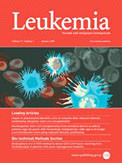Balgobind BV, Lugthart S, Hollink IH, Arentsen-Peters ST, van Wering ER, de Graaf SS, Reinhardt D, Creutzig U, Kaspers GJ, de Bont ES, Starý J, Trka J, Zimmermann M, Beverloo HB, Pieters R, Delwel R, Zwaan CM, van den Heuvel-Eibrink MM. Leukemia. 2010 May;24(5):942–9. Epub 2010 Apr 1. IF: 8.926

Abstract:
Overexpression of the ecotropic virus integration-1 (EVI1) gene (EVI1+), localized at chromosome 3q26, is associated with adverse outcome in adult acute myeloid leukemia (AML). In pediatric AML, 3q26 abnormalities are rare, and the role of EVI1 is unknown. We studied 228 pediatric AML samples for EVI1+ using gene expression profiling and RQ-PCR. EVI1+ was found in 20/213 (9 %) of children with de novo AML, and in 4/8 with secondary AML. It was predominantly found in MLL-rearranged AML (13/47), monosomy 7 (2/3), or FAB M6/7 (6/10), and mutually exclusive with core-binding factor AML, t(15;17), and NPM1 mutations. Fluorescent in situ hybridization (FISH) was performed to detect cryptic 3q26 abnormalities. However, none of the EVI1+ patients harbored structural 3q26 alterations. Although significant differences in 4 years pEFS for EVI1+ and EVI1– pediatric AML were observed (28 % ± 11 vs 44 % ± 4, P = 0.04), multivariate analysis did not identify EVI1+ as an independent prognostic factor. We conclude that EVI1+ can be found in approximately 10 % of pediatric AML. Although EVI1+ was not an independent prognostic factor, it was predominantly found in subtypes of pediatric AML that are related with an intermediate to unfavorable prognosis. Further research should explain the role of EVI1+ in disease biology in these cases. Remarkably, no 3q26 abnormalities were identified in EVI1+ pediatric AML.
-az-
